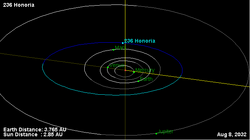Astronomy:236 Honoria
 Orbital diagram | |
| Discovery | |
|---|---|
| Discovered by | Johann Palisa |
| Discovery date | 26 April 1884 |
| Designations | |
| (236) Honoria | |
| Pronunciation | /hɒˈnɔːriə/[1] |
| Named after | Justa Grata Honoria |
| A884 HA, 1904 PA 1930 KK ,1953 GJ1 | |
| Minor planet category | Main belt |
| Orbital characteristics[2] | |
| Epoch 31 July 2016 (JD 2457600.5) | |
| Uncertainty parameter 0 | |
| Observation arc | 131.97 yr (48201 d) |
| |{{{apsis}}}|helion}} | 3.3307 astronomical unit|AU (498.27 Gm) |
| |{{{apsis}}}|helion}} | 2.2651 AU (338.85 Gm) |
| 2.79787 AU (418.555 Gm) | |
| Eccentricity | 0.19042 |
| Orbital period | 4.68 yr (1709.4 d) |
| Average Orbital speed | 17.8 km/s |
| Mean anomaly | 294.554° |
| Mean motion | 0° 12m 38.16s / day |
| Inclination | 7.6942° |
| Longitude of ascending node | 185.861° |
| 174.872° | |
| Physical characteristics | |
| Dimensions | 86.20±3.7 km |
| Rotation period | 12.336 h (0.5140 d) |
| Geometric albedo | 0.1271±0.012 |
| S | |
| Absolute magnitude (H) | 8.18 |
Honoria (minor planet designation: 236 Honoria) is a large main belt asteroid that was discovered by Austrian astronomer Johann Palisa on 26 April 1884 in Vienna. The asteroid was named after Honoria, granddaughter of the Roman Emperor Theodosius I, who started negotiations with Attila the Hun. It is classified as a stony S-type asteroid based upon its spectrum. 236 Honoria is orbiting close to a 5:2 mean motion resonance with Jupiter, which is located at 2.824 astronomical unit|AU.[3]
Polarimetric study of this asteroid reveals anomalous properties that suggests the regolith consists of a mixture of low and high albedo material. This may have been caused by fragmentation of an asteroid substrate with the spectral properties of CO3/CV3 carbonaceous chondrites.[4]
References
- ↑ 'Honorius' in Noah Webster (1884) A Practical Dictionary of the English Language
- ↑ Yeomans, Donald K., "236 Honoria", JPL Small-Body Database Browser (NASA Jet Propulsion Laboratory), https://ssd.jpl.nasa.gov/sbdb.cgi?sstr=236, retrieved 12 May 2016.
- ↑ Hahn, G. et al. (June 1991), "Orbital evolution studies of asteroids near the 5:2 mean motion resonance with Jupiter", Astronomy and Astrophysics 246 (2): 603–618, Bibcode: 1991A&A...246..603H.
- ↑ Gil-Hutton, R. et al. (April 2008), "New cases of unusual polarimetric behavior in asteroids", Astronomy and Astrophysics 482 (1): pp. 309–314, doi:10.1051/0004-6361:20078965, Bibcode: 2008A&A...482..309G.
External links
- The Asteroid Orbital Elements Database
- Minor Planet Discovery Circumstances
- Asteroid Lightcurve Data File
- 236 Honoria at AstDyS-2, Asteroids—Dynamic Site
- 236 Honoria at the JPL Small-Body Database
 |

